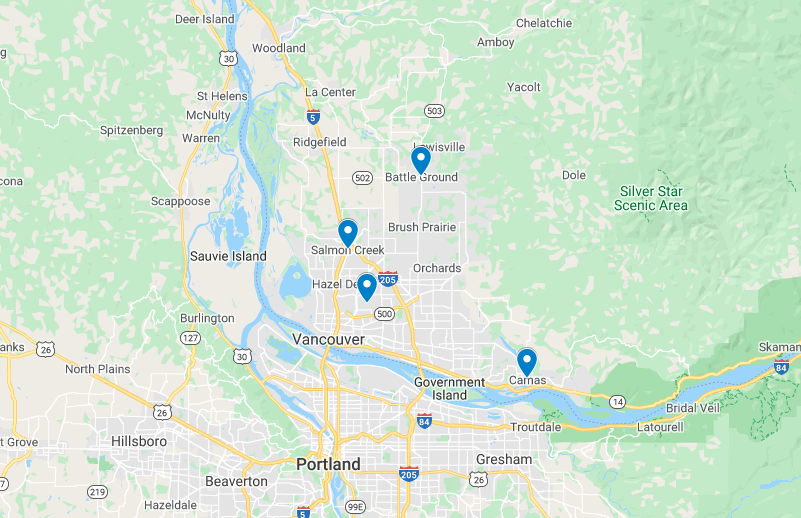Ladders are a common tool used in many industries, from construction and maintenance to retail and hospitality. While ladders are essential for tasks that require reaching high places, they can also be incredibly dangerous if not used properly. According to the Occupational Safety and Health Administration (OSHA), falls from ladders account for over 20% of all workplace fatalities. In this blog post, we will discuss some important tips and guidelines for ladder safety that can help prevent accidents and injuries.
Improper use of ladders is one of the leading causes of accidents and injuries in the U.S. For its seventh year, the American Ladder Institute (ALI) is sponsoring National Ladder Safety Month to raise awareness of ladder safety. They hope to decrease the number of ladder-related injuries and fatalities both at home and in the workplace by focusing on learning how to use this equipment safely. Use the right type of ladder for the job and maintain good climbing habits to avoid falling.
Just about every business and home has a ladder. They are a quick and easy way to get up high. Many people use them to access the roof of their building or throughout the construction process and when working with utilities, but this equipment can easily lead to injury and even death when not used properly. According to the CDC, each year, around one hundred people die, and thousands more are injured from ladder-related falls. They regularly make the yearly top 10 workplace safety citations on OSHA’s list of the most hazardous work-related risks. But these deaths and accidents can easily be prevented by making sure you are using your ladder correctly.
Choose
Search by product name, product #
Search by product name, product #
Free US shipping on orders $199 or more. Learn more
Home
/
Blog
/
National Ladder Safety Month
National Ladder Safety Month
Posted by PK Safety Team on Fri Mar 03rd, 2023
Search our Blog
Improper use of ladders is one of the leading causes of accidents and injuries in the U.S. For its seventh year, the American Ladder Institute (ALI) is sponsoring National Ladder Safety Month to raise awareness of ladder safety. They hope to decrease the number of ladder-related injuries and fatalities both at home and in the workplace by focusing on learning how to use this equipment safely. Use the right type of ladder for the job and maintain good climbing habits to avoid falling.
Just about every business and home has a ladder. They are a quick and easy way to get up high. Many people use them to access the roof of their building or throughout the construction process and when working with utilities, but this equipment can easily lead to injury and even death when not used properly. According to the CDC, each year, around one hundred people die, and thousands more are injured from ladder-related falls. They regularly make the yearly top 10 workplace safety citations on OSHA’s list of the most hazardous work-related risks. But these deaths and accidents can easily be prevented by making sure you are using your ladder correctly.
Keep these tips in mind when scaling heights on a ladder:
Choosing a Ladder
Staying safe means using the right type of ladder for the job. Ladders can vary in height — anywhere from several feet to over 40 feet high. Ladders that are too short or too tall can be hazardous. Measure the maximum height of the surface area you need to reach, such as the roof or gutters of the building. You can use either a leaning extension ladder or a self-supporting step ladder. There are ladders that can be used in confined space descent and rescue like the DBI Rollgliss Synthetic Rescue Ladder or the French Creek Flexible Access Ladder. These need to be long enough to reach the
When choosing an extension ladder, find a ladder that is seven to twelve feet higher than the height of the gutters or support point. Use a 16-foot ladder when trying to reach a 9-foot height. Use a 40-foot ladder to reach 28 to 31 feet off the ground.
When using a step ladder, you generally need one that’s four feet shorter than the maximum height you’re trying to reach. For example, if you need to reach a level seven feet off the ground, use a ladder that’s three feet high. If you need to reach a 20-foot height, use a 16-foot ladder. The top cap should not be used as a step.
Ladders can also be made of different materials, including fiberglass, wood, aluminum, steel, or polyester webbing. Fiberglass ladders tend to be the most expensive and the most reliable. They are electrically non-conductive, which means they are safe to use around electrical wires. Do not use a metal ladder when working near electrical equipment or wires to prevent electrocution. Wood ladders are also non-conductive when they are clean and dry, but they can break apart over time. The wood can chip and spread debris, making the ladder less structurally sound. Metal ladders should only be used in areas free of electrical equipment. They are lightweight, durable, and come with corrosion resistance. Confined space rescue and descent ladders that are made of webbing should be examined before each use to ensure there is no damage to the webbing or stitching.
Examine the work site to make sure you are using the right ladder for the job. When using a ladder for a specific task, inspect it for damage. If any part of the ladder appears weak or loose, remove it from circulation and buy a new ladder right away.
Climbing the Ladder
Put the ladder in position and check to ensure it feels stable and secure before climbing. You should be wearing shoes with a firm grip and safety gloves if necessary. Inspect the steps and handles on the ladder to see if they are dry. Avoid climbing the ladder when wet to reduce your chances of slipping. The team should stop using the ladder as soon as it starts raining or the weather takes a turn for the worst.
Check all the safety information and warning labels on the ladder and follow the instructions as listed. All the locks and mounting mechanisms on the ladder should be engaged to prevent displacement. If the ladder comes with accessories, such as hooks or extensions, you should only use them as instructed.
You should never use the ladder for anything other than its designed function. Do not use a step ladder when it is partially closed, and don’t put your weight on the top step of the ladder unless it was designed for that purpose. Don’t put anything underneath the ladder to extend the height, such as a box or chair that could slide out from under the ladder.
When climbing the ladder, maintain at least three points of contact at all times, such as two feet and one hand or two hands at one foot. Keep your body centered on the ladder, and avoid leaning to one side. Face the ladder when climbing and look straight ahead.
If the ladder has a three-foot extension, it should only be deployed at least three feet above the level of support. Do not stand on the top three steps of a straight, single ladder or ladder extension.
Workers should also wear the required safety gear for the task at hand, such as work gloves and a hard hat to protect their heads.
It is often best to have a supervising worker keep a hand on the ladder when someone else is using it. They can provide additional stabilization and support to prevent the ladder from falling over.
Consider the Duty Rating
The duty rating represents how much weight the ladder can hold. You should never place more than the recommended amount of weight on the ladder. ALI suggests a simple equation to determine what duty rating is best for your project: you’ll need to know the weights of the worker, any clothing and equipment, and the tools and supplies. Add these numbers to find the corresponding duty rating.
Type III duty rating can support 200 pounds
Type II duty rating can support 225 pounds
Type I duty rating can support 250 pounds
Type IA duty rating can support 300 pounds
Type IAA duty rating can support 375 pounds
Ladders are not invincible. They are valuable pieces of equipment and should be treated as such. Store your ladder in a secure, dry room temperature location where it won’t get damaged. You can mount it on the wall to keep it out of the way. Avoid leaving the ladder set up for long periods of time when it is not in use so it doesn’t get knocked over. Carrying ladders can also pose hazards for some by knocking equipment over or having the channel bite shoulders. Before moving a ladder, make sure there is plenty of clearance to do so. Working Concepts’ Pak a Ladder provides a safer carry method for service workers by giving them better control and ergonomics when carrying step ladders.
Everyone using the ladder should be trained on how to use it properly. Employers can post safety information in and around the workplace to keep workers informed. The company can run regular ladder training sessions to educate workers.
Inspect the Ladder Before Use
Once you have selected the right ladder for the job, it is important to inspect it thoroughly before use. Check for any cracks, bends, or other damage that could compromise the ladder’s stability. Make sure that all the rungs are In good shape, are not cracked, and have all of the gripping intact.
Setting the ladder up is something that should be done correctly, and if not can cause serious injury. When setting a ladder up, You should always use a 4 to 1 ratio. Approximately 75° is the general rule of thumb. For every four feet in height. The base of the ladder should be removed one foot from the wall or structure. For example, a 20 ft ladder should be placed about 5 ft from the base of the wall that you will be accessing and working at.
What’s the ladder at the right angle? Then you are ready to extend the ladder and attach it to the side of the building or structure that you will be climbing up. Many times, people that are homeowners and not professional contractors are not aware that there are different devices that can help. The person on the ladder feels much more secure and safe while working at heights.
One of these devices that will make you feel much more insecure and safe while working at heights on a ladder is a ladder standoff or ladder stabilizer.
When using a ladder stabilizer, the weight and distribution of mass from the top of the ladder no longer rest on the ladder. The stabilizer pushes the ladder away and gives a much more secure and safe surface to work from.
That only is it a much safer way to stand your ladder from the top of the surface so that you do not slide around when working at the top of the ladder but ladder stabilizers or ladder standoffs also allow the technician working on the house or building to not scratch the gutter surface that the ladder is sitting on.
Once you know that the ladder is secure and at the right angle, you can begin walking up the ladder. When walking up. Louder is imperative to always use three points of contact. 3 points of contact are used at all times so that in case there is a slip, you can recover safely and not fall.
As you climb the ladder with three points of contact, you can now get to the top and begin working off of the top of the ladder or begin to dismount the ladder onto the rooftop.
Dispounding a ladder from the steps or rungs of the ladder onto the top of the rooftop is always the scariest part of using the ladder.
To do this, it is imperative that you maintain two hands on the ladder as you step from the ladder to the rooftop.
Using the correct footwear while working on a rooftop is another precaution that can vastly and greatly increase the safety of the technician that is working on the rooftop.
Getting back onto the ladder also is one of the more dangerous parts of using a ladder and working at heights. Using extra caution and always using three points of contact, mounting the ladder slowly using two hands on the top of the ladder is always best.
Always make sure that whoever is using the ladder at your home or business is properly trained, educated and prepared to use the correct ladder for the job and knows how to use it.








